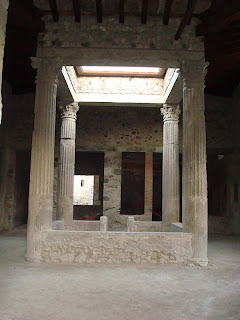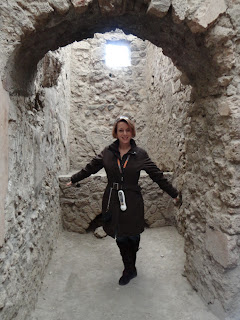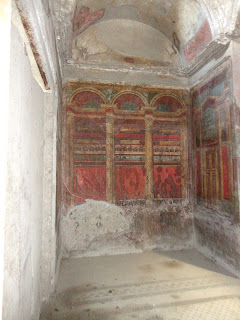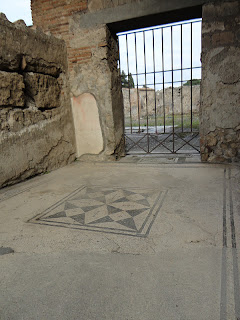Pompeii
Travels with Kelly
Me hanging out in the Forum
My sweet and sassy sista friend has to make a choice between seeing Pompeii and Naples. Seeing as I have been to both I thought it might be fun to do blog posts on the two cities to help her choose.
I was blown away by Pompeii. Sure, I had briefly studied Pompeii as a kid, and caught the odd documentary, but nothing prepared me for the experience. The first thing that completely blew me away was the size. I don’t know exactly why, but I was under the impression that Pompeii was much smaller. It wasn’t. It was absolutely overwhelmingly large.
The second thing that caught me off guard was the degree of preservation. A large portion of the walls still retained portions of paint. Statues stood where they had centuries ago. Tile floors remained more or less where the home owners had installed them. The streets were largely in good enough repair to be used today. It was unbelievable. It was eerie. It was unbelievably eerie.
 This is the first view after you buy tickets. The archeologists say that this would have been access to the sea which is pretty unbelievable because that means a whole lot of real estate has been added since Pompeii was an active city.
This is the first view after you buy tickets. The archeologists say that this would have been access to the sea which is pretty unbelievable because that means a whole lot of real estate has been added since Pompeii was an active city. Here we are in one of the bakeries. There really isn’t much that needs left to the imagination. The top stone rotated (by the animal or slave force) over the fixed lower stone to grind the grain. You can still see where the sticks would have been installed in the top stones. The bread would rise in one area then be placed in ovens for baking. These photos were taken in three separate bakeries found throughout the town.
The back story: It was more or less a normal day in Pompeii in 79AD. There was a lot of renovation going on because there had been an earthquake in 62AD and in typical fashion...it was taking a while. People were shopping, eating, working, planning…doing the same things we do today. Out of nowhere, Mount Vesuvius started erupting. The citizens were shocked and confused because Vesuvius had been deemed an extinct in 20AD and therefore no threat whatsoever. Well, as we all know, that was a slight miscalculation. The volcano erupted with such ferocity that the top of the mount collapsed making the caldera you see today. Pompeii wasn’t the only city affected, nor is it the only excavated city you can visit. It has been relatively simple for excavation though and because of that majority of the city is uncovered and open for exploration. Large sections still remain under roughly six meters of settled ash and excavation continues.
Me and the bimbi where justice was dispensed.

 The Forum was once the center of town. Now, this was an always expanding city of some 20,000 residents, so there were other areas that functioned somewhat similarly. There were several areas scattered about that had cashes of pottery and statuary. These were once used to hold grain and goods for sale.
The Forum was once the center of town. Now, this was an always expanding city of some 20,000 residents, so there were other areas that functioned somewhat similarly. There were several areas scattered about that had cashes of pottery and statuary. These were once used to hold grain and goods for sale. |
| Inside the Roman Baths |

 The chariots all had standard wheel bases and the streets were flooded daily for washing. stone were raised periodically to act as stepping stones.
The chariots all had standard wheel bases and the streets were flooded daily for washing. stone were raised periodically to act as stepping stones. |
| Random family photo |
The Amplitheater
Legand has it that the peopel behaved badly and they got their games taken away from them for TEN YEARS! But just three years later everyone was devastated by the earthquake so he lifted the ban.

 This is the best example of an Ipluvium that I have a photo of. Implouviums were sort of standard in Greek or Roman homes of this period and were placed in the atrium to collect rain water from the roof.
This is the best example of an Ipluvium that I have a photo of. Implouviums were sort of standard in Greek or Roman homes of this period and were placed in the atrium to collect rain water from the roof. The Theater
This is one of theaters where plays and what not would be preformed
There are lights, row numbers and seat numbers installed. I seem to recall something about Pink Floyd performing in Pompeii in the 70's, but I seriously thought it was just an album title...could have happened. This really makes a metal fest at a Ferrari race track seem pretty lame.
The Walls
 There were tons of Frescos on walls from a bunch of different periods. Pompeii had been developing for centeries. It had been ruled by all sorts of different folks and influenced by even more cultures through its port. The art is broken into four styles ranging from nearly kindergarten basic through pretty darn advanced. This is an example of Style II known as perspective architecture.
There were tons of Frescos on walls from a bunch of different periods. Pompeii had been developing for centeries. It had been ruled by all sorts of different folks and influenced by even more cultures through its port. The art is broken into four styles ranging from nearly kindergarten basic through pretty darn advanced. This is an example of Style II known as perspective architecture.  This is a great example of Style III or Real Wall Style. I snapped this shot when we hiked out to Villa Dei Misteri. All the land inside the city walls had been pretty much spoken for so amazing places started popping up a bit further out. This villa was still amazing today despite having been covered in ashe for centeries.
This is a great example of Style III or Real Wall Style. I snapped this shot when we hiked out to Villa Dei Misteri. All the land inside the city walls had been pretty much spoken for so amazing places started popping up a bit further out. This villa was still amazing today despite having been covered in ashe for centeries. This has nothing to do with painting styles, but there is an intact add on the side of this place! One of the houses we visited had an add for borders of its exterior.
This has nothing to do with painting styles, but there is an intact add on the side of this place! One of the houses we visited had an add for borders of its exterior.The people of Pompeii
The people of Pompeii were caught so off guard by the eruption that they were literally stopped in their tracks. The citizens were covered by a thick layer of ash and suffocated. During one of the excavations an archeologist came upon a hollow. They decided to cast the hollow with plaster before continuing. This produced the horrifyingly tragic plaster people. I’m not sure how I feel about this. I’m not a fan of displaying dead for public scrutiny. Mummies in museums seem inherently wrong as does displaying the man who was frozen in ice. These aren’t people, but their terrified or protective body language is nothing if not human. Although most everything decomposed, traces of bone can be seen in some casts which I found more than a little disturbing.
Man's Best Friend
Dogs were prevalent in Pompeii when it was a bustling city and this too remains. The only full time residents are comfortable in their town.
This is a reproduction replacing the origional that was taken to museum. The subject was taken from a famous painting of the time. It is hard to communicate size sometimes in photos. This piece was enormous; however, the stone bits were very tiny to get that sort of detail.
A lot of amazing mosaic floors remain visible. Some of Pompeii’s best is maintained at the Archeological Museum in Naples (reproductions are in place for these), but the remainder is authentic and amazingly well preserved. Here are a few choice examples:
 This is one of the most iconic images of Pompeii mosaic. The words read "Cave Canem" or when translated, "Beware of the Dog". This is my photo and not the clearest, but you can see crystal clear versions of this image all over the web.
This is one of the most iconic images of Pompeii mosaic. The words read "Cave Canem" or when translated, "Beware of the Dog". This is my photo and not the clearest, but you can see crystal clear versions of this image all over the web. This one is sort of twisted if you speak English...as all five of my readers do. It is at the entrace of an AMAZING villa that takes up an ENTIRE city block. The inscription is "HAVE" which the residents clearly were part of the "have" rather than the "have not". The language of the day was not English though, so it bears translating. It is a spelling variant of Ave which means "hail"
This one is sort of twisted if you speak English...as all five of my readers do. It is at the entrace of an AMAZING villa that takes up an ENTIRE city block. The inscription is "HAVE" which the residents clearly were part of the "have" rather than the "have not". The language of the day was not English though, so it bears translating. It is a spelling variant of Ave which means "hail"Let's Eat!
There is always something that I get hung up on when we are visiting any new place. Here it was the restaurants. The common citizen lived in a very small house without a kitchen. Scattered throughout the town were all these sort of lunch counters or the modern equivalent of fast food places. They all sort of followed the same basic format – there was a counter with large clay pots built in. The pots would hold a variety of foods like olives and wine. Some of the places had more or less a grill to go along. Fascinating and charming. I couldn’t pass a single one without snapping a photo or two.
 |
| This one still ahs the origional writing on the facade |
 |
| This one was the best preserved that we found |
This was the best preserved that we found. My book identified it as Thermopolium Of The Lararium . No idea what that means, but the book says the art found in this area contained Mercury (the god of commerce) and Dionysus (the god of wine). How fitting. When they excavated this place, there were coins still in the till.
 |
| a second view |


















































